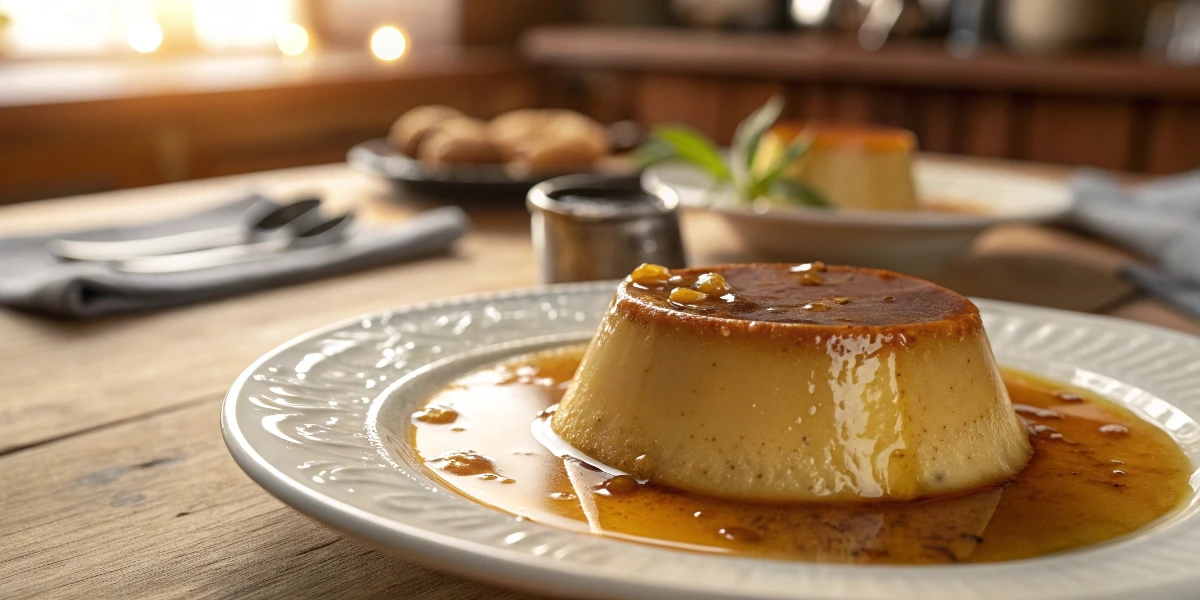Have you ever wondered why crème caramel feels like a fancy dessert reserved for special occasions? What if I told you that this silky, creamy treat is not only simple to make but also incredibly versatile and downright delicious? Whether you’re a seasoned baker or someone who’s just starting in the kitchen, crème caramel can be your next go-to dessert. Let’s dive into everything you need to know about making this classic French delicacy.
Table of Contents
Why Crème Caramel Stands Out
Crème caramel is more than just a dessert—it’s an experience. With its smooth custard base topped with a layer of glossy caramel sauce, it strikes the perfect balance between sweet and rich without being overwhelming. But what makes this dish so special?
- Time Requirements: You’ll need about 45 minutes of active prep time, plus around 1 hour for baking and cooling.
- Difficulty Level: Don’t let the elegant look fool you—this recipe is beginner-friendly!
- Special Factor: It’s all about texture and flavor harmony. The caramel adds a hint of bitterness that cuts through the sweetness of the custard, creating a symphony of flavors.
Crème caramel has a universal appeal. Its roots trace back to European kitchens, where it was cherished as a symbol of indulgence and refinement. Today, it remains a favorite across cultures, often served in restaurants as a nostalgic nod to timeless culinary traditions. The best part? You don’t need expensive tools or exotic ingredients to recreate this magic at home.
Essential Ingredients for Crème Caramel

The beauty of crème caramel lies in its simplicity. Here are the key players:
1. Sugar (for caramelizing)
- Why It Matters: This forms the golden topping that gives crème caramel its signature crunch and sweetness. Without caramel, the dessert would lose its defining feature.
- Alternatives: Brown sugar works too, though it will give a deeper molasses flavor. For those looking to reduce refined sugars, coconut sugar or honey can be experimented with, though they may alter the final taste slightly.
2. Eggs
- Why It Matters: Eggs act as the binder and provide structure to the custard. They also contribute to the silky texture that makes crème caramel so irresistible.
- Alternatives: For a vegan version, try using silken tofu or plant-based egg substitutes like aquafaba (the liquid from canned chickpeas). While these alternatives won’t replicate the exact texture of traditional eggs, they come close enough for most palates.
3. Milk (or cream)
- Why It Matters: Milk creates the creamy base of the custard. Whole milk is ideal because of its fat content, which ensures a luscious mouthfeel. Heavy cream adds extra decadence, while lower-fat options like skim milk can work in a pinch.
- Alternatives: Almond milk, coconut milk, or oat milk work well for dairy-free options. Coconut milk, in particular, lends a tropical twist, while almond milk keeps things light and nutty.
4. Vanilla Extract
- Why It Matters: A splash of vanilla enhances the overall aroma and taste. It complements the caramel beautifully and ties the flavors together.
- Alternatives: Use a vanilla bean pod for a more intense flavor. Simply scrape the seeds into the milk mixture before heating. Alternatively, almond extract or even a dash of cinnamon can add unique dimensions to the dessert.
5. Salt
- Why It Matters: Just a pinch balances out the sweetness and brings depth to the dish. Salt might seem minor, but it plays a crucial role in elevating the other flavors.
Pro Tip: Always use fresh, high-quality ingredients. Fresh eggs and pure vanilla extract make a noticeable difference in the final product.
Step-by-Step Instructions for Making Crème Caramel

Ready to get started? Follow these easy steps to create your own masterpiece:
Step 1: Prepare Your Caramel
- Heat sugar in a saucepan over medium heat until it melts and turns amber-colored. Stir occasionally to prevent burning.
- Swirl the pan gently to ensure even caramelization—don’t stir!
- Once melted, pour the caramel into ramekins or a baking dish, tilting to coat the bottom evenly. Let it cool and harden.
Pro Tip: Keep an eye on the caramel—it can burn quickly! If you see smoke, it’s probably done. Work in a well-ventilated area, as caramelizing sugar can produce strong fumes.
Step 2: Make the Custard Base
- Whisk eggs, milk, sugar, vanilla extract, and salt together in a bowl until smooth. Avoid overmixing, as air bubbles can affect the texture.
- Strain the mixture through a fine sieve to remove any lumps and achieve a velvety texture. This step is optional but highly recommended for professional results.
Step 3: Assemble and Bake
- Pour the custard mixture over the hardened caramel in the ramekins.
- Place the ramekins in a larger baking pan and fill the pan halfway with hot water (this is called a bain-marie ).
- Bake at 325°F (160°C) for 40–45 minutes, or until the custard is set but still slightly jiggly in the center.
Cooking Tip: To check doneness, insert a toothpick into the custard. If it comes out clean, it’s ready! Overbaking can lead to cracks, so err on the side of caution.
Step 4: Cool and Chill
- Remove the ramekins from the water bath and let them cool to room temperature.
- Refrigerate for at least 4 hours, or overnight, to allow the flavors to meld and the custard to firm up.
Assembly Tips for a Picture-Perfect Dessert
Now that your crème caramel is baked, here’s how to present it beautifully:
- Run a knife around the edges of each ramekin to loosen the custard.
- Flip the ramekin onto a plate, giving it a gentle shake to release the dessert.
- Watch as the caramel drips down the sides, creating a stunning glaze.
Presentation Hack: Garnish with fresh berries, mint leaves, or a dusting of powdered sugar for added flair. For a festive touch, drizzle additional caramel sauce or chocolate syrup over the top.
Storage and Reheating Tips for Freshness
If you have leftovers (unlikely!), store them properly to maintain their quality:
- Refrigeration: Cover the ramekins with plastic wrap or place them in an airtight container. They’ll stay fresh for up to 3 days.
- Freezing: While freezing isn’t recommended due to potential texture changes, you can freeze individual portions for up to 1 month. Thaw overnight in the refrigerator before serving.
- Reheating: Warm individual portions in the microwave for 10–15 seconds, or serve chilled—it tastes amazing either way.
Storage Tip: Label your containers with dates to keep track of freshness. Always refrigerate within two hours of preparation to prevent spoilage.
Creative Recipe Variations for Every Palate
Want to switch things up? Try these fun twists:
Chocolate Crème Caramel
Add cocoa powder or melted chocolate to the custard mixture for a rich, indulgent twist. Top with whipped cream and shaved chocolate for extra decadence.
Spiced Version
Infuse the milk with cinnamon sticks, nutmeg, or star anise for a warm, cozy flavor. Perfect for fall gatherings or holiday feasts.
Citrus Zest
Add lemon or orange zest to brighten the custard. The citrus notes pair wonderfully with the caramel’s sweetness.
Coffee Lover’s Dream
Stir in a tablespoon of instant coffee granules for a mocha-inspired treat. Serve with a shot of espresso on the side for true coffee enthusiasts.
Vegan Crème Caramel
Substitute eggs with silken tofu and use coconut milk for a creamy, dairy-free alternative. Finish with a sprinkle of sea salt for contrast.
Health Benefits of Crème Caramel
While crème caramel is undeniably indulgent, it does offer some nutritional benefits when enjoyed in moderation:
- Protein Powerhouse: Eggs are packed with high-quality protein, essential for muscle repair and overall health.
- Calcium Boost: Milk provides calcium, which supports bone health and nerve function.
- Energy Source: Natural sugars from the caramel provide quick energy, making it a satisfying post-meal treat.
- Mood Enhancer: The combination of comforting flavors and textures can elevate mood and reduce stress.
Health Tip: Opt for low-fat milk or reduce the amount of sugar in the recipe to make it slightly lighter. Pair it with fresh fruit for a balanced dessert option.
Why You Should Give Crème Caramel a Try Today
Crème caramel isn’t just a dessert; it’s a celebration of simplicity and elegance. With minimal ingredients and straightforward techniques, you can whip up a show-stopping dessert that will impress family and friends alike. Plus, its health benefits—like protein from eggs and calcium from milk—make it a guilt-free indulgence when enjoyed in moderation.
So, grab your apron and give this timeless recipe a shot. Trust me, one bite of your homemade crème caramel will leave you wondering why you didn’t try it sooner!
FAQs About Crème Caramel
Q1: Can I make crème caramel ahead of time?
Absolutely! In fact, preparing it a day in advance allows the flavors to meld together beautifully. Just refrigerate until ready to serve.
Q2: Is crème caramel gluten-free?
Yes! Since it doesn’t contain flour, it’s naturally gluten-free, making it suitable for those with dietary restrictions.
Q3: How do I prevent cracks in my custard?
Avoid overbaking, and make sure to use a bain-marie for even heat distribution. Also, let the custard cool gradually to minimize stress on the surface.
Q4: Can I freeze crème caramel?
While freezing isn’t recommended (as it may affect texture), it can be stored in the fridge for several days. Freeze only if absolutely necessary, and thaw slowly in the refrigerator.
Q5: Are there health benefits to eating crème caramel?
Eggs provide high-quality protein, while milk offers essential vitamins and minerals. Just enjoy it in moderation for a guilt-free treat.
There you have it—a complete guide to mastering the art of crème caramel. Go ahead, unleash your inner chef, and savor every spoonful of this heavenly dessert. Bon appétit.

